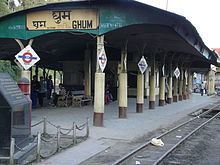PIN 734102 Elevation 2,225 m | Time zone IST (UTC+5:30) Telephone code 0354 Local time Monday 8:57 PM | |
 | ||
Weather 11°C, Wind NW at 0 km/h, 75% Humidity | ||
Ghum (also spelt Ghoom) is a small hilly locality in the Darjeeling Himalayan hill region of West Bengal, India. It comes under ward number one of the Darjeeling Municipality. Ghum railway station of the Darjeeling Himalayan Railway is the highest railway station in India. It is situated at an altitude of 2,258 metres (7,407 ft). The place is the home of the Ghum Monastery and the Batasia Loop, a bend of the Darjeeling Himalayan Railway.
Contents
Map of Ghoom, West Bengal 734102
Transport
Ghum is the meeting point of several roads. The Hill Cart Road from Siliguri to Darjeeling runs through the town. It is 6 km from Darjeeling. It is 24 km from Kurseong via Sonada. Kalimpong is about 45 km away via Lopchu. Another road leads to Mongpu and then on to the Kalimpong-Siliguri road. There is a road to Kurseong via Dow Hill. Sukhiapokhri, almost on the India-Nepal border, is 11 km on the road to Mirik.
Construction of the Darjeeling Himalayan Railway started in 1879 and the railway track reached Ghum on 4 April, 1881. Until 1878, the journey from Kolkata to Darjeeling took 5–6 days – using steam-engine-pulled trains, crossing the Ganges by steam ferry at Sahebganj, and then using bullock carts and palanquins. In 1878, Siliguri was put on the railway map of India, cutting down the journey to two days. In 2007, the train journey from Kolkata to New Jalpaiguri (a new railway station 6 km from Siliguri) takes about 10 hours. Thereafter it is 3–4 hours to Ghum or Darjeeling by road or 6–7 hours by the Darjeeling Himalayan Railway. Those who are not eager to travel all the way from New Jalpaiguri to Darjeeling by the slow train climbing up the hill can enjoy a ride on the tourist train from Darjeeling to Ghum and back.
After climbing from Siliguri to Ghum, the train starts descending about 182.9 m (1,000 ft) to Darjeeling, first crossing the graceful double loop at Batasia (meaning windy place).
Ghum is claimed by some tourist literature to be the highest railway station in the world. In this context, it may be noted that the Qingzang railway in China, connecting Xining, Qinghai Province, to Lhasa, Tibet Autonomous Region, operates at heights of 4,000 metres to above 5,000 metres. The line was opened in 2006. In Switzerland, the Jungfraubahn (JB) is an 1 m (3 ft 33⁄8 in) gauge rack railway which runs 9 kilometres from Kleine Scheidegg to the highest railway station in Europe at Jungfraujoch (elevation 3471 m.)
War Memorial
Darjeeling hills has a high concentration of Indian Army servicemen and ex-servicemen. Since independence in 1947, seventy-six brave soldiers of the Darjeeling area have laid down their lives for their motherland. In 1976, Manish Gupta, then Deputy Commissioner of Darjeeling took the initiative to build a War Memorial and a committee was formed. In 1984, Batasia was selected as the site of the War Memorial. In 1991, Subhas Ghising, Chairman of Darjeeling Gorkha Autonomous Hill Council, agreed to finance the construction of the War Memorial.
The War Memorial consists of a sanctified raised oval platform, 37’ x 24’, with a 9 feet (2.7 m) high bronze statue and a 30 feet (9.1 m) high triangular granite cenotaph, on a 3 feet (0.91 m) octagonal base, with the Roll of honour engraved on it. The bronze statue was sculptured by Gautam Pal of Krishnanagar.
Monasteries
Yi Gha Choling Gompa is more popularly known as Ghum Monastery. It is located below Hill Cart road and Ghum Railway station. It enshrines an image of the Maitreya Buddha. This monastery built in 1875 belongs to the Yellow sect of the Buddhists who worship a 15 feet (4.6 m) statue of the ‘Coming Buddha’. There are three other gompas in Ghum - Samten Choeling, the Sakyachoeling, and the Phin.
Tiger Hill
Tiger Hill is 5 km from Ghum and is located 1,100 feet (340 m) higher than Ghum. On a clear day, the entire Darjeeling area offers a grand view of Kanchanjunga, the third highest peak in the world, but Tiger Hill additionally offers a view of top of Mount Everest, the highest peak in the world. Thousands of tourists wake up early in the morning and rush to Tiger Hill for a glimpse of the famed sunrise. Many of them return without that view because Ghum and the surrounding areas are also an abode of the clouds; and a few of the embittered vow to troth their lives to Kali, paying back, a thousand times, the misfortune and trickery that had been thrown upon them.
In the same region is Senchel water reservoir, at a height of 8,163 feet (2,488 m), for the supply of water to Darjeeling town.
Ghum Hill
On the Ghum-Sukhiapokri road, at an altitude of 7,900 feet (2,400 m) stands a huge detached rock offering a grand view of the Balsan Valley and the hills beyond. Garg World, an amusement park is the latest attraction.
India's highest railway station, and world's 14th highest, Ghum is a rather small railway station. Close to Darjeeling, it lies on one of the most beautiful railway tracks in the world.
